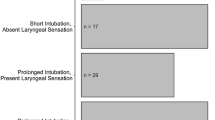Abstract
Laryngopharyngeal sensation is important in the normal process of swallowing, it is often impaired after neurological events and it has been common practice in such an occurrence to order non-oral tube feeding to prevent aspiration. This study assesses a novel approach to the evaluation of the laryngopharyngeal sensation that allows for improved triage of aspiration risk and more lenience towards oral feeding. This is a case series with follow-up period ranging from 6 to 24 months. Forty patients with neurological deficiencies were tested by a modified laryngopharyngeal sensation study that included evaluation of both supra and infra-glottis. All patients had impaired supra glottic sensation but had good infra glottic sensation that enabled cough protection. All had received oral feeding. Main outcome measure is incident aspiration pneumonia. Twenty-two patients maintained oral feeding without any evidence of aspiration. Eighteen patients had some aspirations associated with cough, and were maintained on modified oral feeding. Out of these 18 patients, four patients (10% of the entire group) developed aspiration pneumonia. The presented procedure identified patients with impaired supraglottic sensation but preserved good infra glottic sensation. This observation enables safe oral feeding in most patients and therefore offers a better quality of life for these individuals.
Similar content being viewed by others
References
Aviv JE, Sacco RL, Mohr JP, Tompson JLP, Levin B, Sunshine S, Thomson J, Close LG (1997) Laryngopharyngeal sensory testing with modified barium swallow as predictors of aspiration pneumonia after stroke. Laryngoscope 107:1254–1260
Greshom SL (1990) Clinical assessment and management of swallowing difficulties after stroke. Med J Aust 153:397–399
Donner M (1974) Swallowing mechanisms and neuromuscular disorders. Semin Roentgenol 9:273–282
Smith DBA, Dohl T, Lindow CF, Sanset PM, Rostad B, Albidgard U (1989) Fatalities in Stroke unit. Oslo City Hosp 39:31–37
Kidd D, Lawson J, Nesbitt R, MacMahon J (1993) Aspiration in acute stroke: a clinical study with videofluoroscopy. Q J Med 86:825–829
Kidd D, Lawson J, Nesbitt R, Mac Mahov J (1995) The natural history and clinical consequences of aspiration in acute stroke. Q J Med 88:409–413
Andrew BL, Oliver J (1951) The epiglottal taste buds of the rat. J Physiol 114:48
Williams PL, Warwick R (eds) (1980) Gray’s anatomy of the human body, 36th edn. Churchill Livingstone, Edinburgh, pp 1239–1240, 1247
Maranillo E, Leon X, Quer M, Orus C, Sanudo JR (2003) Is the external laryngeal nerve an exclusively motor nerve? The cricothyroid connection branch. Laryngoscope 113:525–529
Miller AJ (1986) Neurophysiological basis of swallowing. Dysphagia 1:91–100
Miller A, Biegler D, Conklin JC (1997) Functional controls of deglutition. In: Perlman AL, Shulze-Delrien K (eds) Deglutition and its disorders. Singular, San Diego, pp 43–98
Aviv JE, Sacco RL, Thomson J, Tandon R, Diamond B, Martin JH, Close L (1997) Silent laryngopharyngeal sensory deficits after stroke. Ann Otol Rhinol Laryngol 106:87–93
Aviv J (2000) Prospective, randomized outcome study of endoscopy versus modified barium swallow in patients with dysphagia. Laryngoscope 110:563–574
Aviv JE, Sacco RL, Diamond B, Kim T, Goodhart K, Kaplan S, Close LG (1998) A new bedside endoscopic test of the motor and sensory components of swallowing. Ann Otol Rhinol Laryngol 107:378–387
Groher ME (1994) The detection of aspiration and videofluoroscopy. Dysphagia 9:147–148
Crogan JE, Burke EM, Caplan S, Denman S (1994) Pilot study of 12-month outcomes of nursing home patients with aspiration on videofluoroscopy. Dysphagia 9:141–146
Feinberg MJ, Knebl J, Tully J (1996) Prandial aspiration and pneumonia in an elderly population followed over 3 years. Dysphagia 11:104–109
Author information
Authors and Affiliations
Corresponding author
Rights and permissions
About this article
Cite this article
Flaksman, H., Ron, Y., Ben-David, N. et al. Modified endoscopic swallowing test for improved diagnosis and prevention of aspiration. Eur Arch Otorhinolaryngol 263, 637–640 (2006). https://doi.org/10.1007/s00405-006-0031-0
Received:
Accepted:
Published:
Issue Date:
DOI: https://doi.org/10.1007/s00405-006-0031-0




